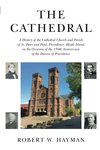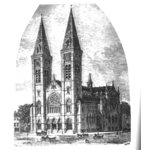

PROVIDENCE — As the central hub of diocesan life for the past century-and-a-half, the Cathedral of SS. Peter and Paul is certainly terra cognita for most Rhode Island Catholics. Many readers, for instance, will already know that the tomb of Bishop Thomas Hendricken is situated adjacent to the cathedral’s western wall. Even those who attend Mass there weekly, however, are likely unaware that the eastern wall of the cathedral is built over an equally historic set of remains: the nearly 200-year-old-wooden skeleton of the parish’s original structure.
“The current cathedral is built on the footprint of the original building, except that it is much, much larger,” explained Father Robert W. Hayman, Ph.D., the author of a new book on the cathedral’s history. “And because it was built on a hill, expanding that footprint meant that they were going to need something to use as fill to create a level platform. So the old church was used as the fill, and it’s now located beneath the eastern wall of the new church.”
The construction of that church occupies the first chapter of Father Hayman’s “The Cathedral: A History of the Cathedral Church and Parish of SS. Peter and Paul, Providence,” now available from Stillwater River Publications. The book can also be purchased through Amazon.com.
A native of Pawtucket, Father Hayman is the official archivist and historian for the Diocese of Providence, and served for 36 years as an assistant professor of history at Providence College, retiring in June 2010. Loyal readers of Rhode Island Catholic will also be acquainted with his regular contributions on the history of the diocese.
They may not be familiar with Father Hayman’s full-length historical works, however: although his “Catholicism in Rhode Island and the Diocese of Providence” has been the definitive history of the local church since the first volume appeared in 1982, the length and density of the series has garnered them a limited reception outside of historical societies and academic libraries.
“The Cathedral” represents Father Hayman’s first foray into popular history — although he is quick to offer a caveat about the genre classification.
“If you flip to the last pages, you’ll find no shortage of footnotes,” he concedes with a smile. “I made sure this would be accessible to anyone as a popular history, but it’s still entirely academic in its approach.”
Father Hayman hopes that the volume will become the first in a series canvassing the historical parishes of the diocese. He has already commenced work on the next book, focusing on St. Mary’s Church in Newport; he expects to have it completed in time for the 200th anniversary of that parish in 2028.
After that?
“I’m hoping to at least make it to a third book, but I’m just taking it one church at a time,” he explained. “I don’t know how many years the Lord is going to give me, so I’m sticking with one at a time.”
For Father Hayman, the Cathedral of SS. Peter and Paul was the natural choice to begin the series.
“You have to start at the beginning, and as the first parish in Providence, the church really tells the story of the Catholic experience in this city,” he said.
Although the book was published to coincide with the diocese’s recently celebrated 150th anniversary, Father Hayman begins his history long before the Diocese of Providence even existed.
Indeed, when Father John Corey led a small group of Irish immigrants in purchasing a vacant lot at the intersection of Weybosset and Westminster streets in 1832, he had no way of knowing the church planned for the spot would one day house a bishop’s cathedra.
The environment hardly seemed hospitable to Catholicism: as Father Hayman writes, the purchase had to take place surreptitiously through a native-born front man because immigrants were barred from purchasing land and “city residents were adamantly opposed to selling land to Catholics for such a purpose.”
“There was a consistent history of ethnic and religious prejudice against immigrants, beginning with the arrival of the Irish,” explained Father Hayman. “Foreign-born people didn’t gain the right to vote in Rhode Island until 1888. And ethnic prejudice still exists in Rhode Island. It’s still a factor. One of the advantages to studying our history is being able to look at ways we’ve addressed these problems in the past.”
Despite the objections of the land’s original owner (who attempted to buy the lot back at a loss when he discovered what the Irish were actually planning to build), the elegantly simple wooden spires of the initial Church of SS. Peter and Paul soon took their place in Providence’s developing skyline. As told by Father Hayman, the next 50 years would witness the growth of the church from a small immigrant parish to becoming the administrative seat of the Diocese of Hartford.
By the time Providence was made an independent diocese, however, the time had come to replace the building with something larger – and sturdier.
One of the more dramatic passages of “The Cathedral” occurs during the final Holy Week celebrations at the old cathedral, when the sound of cracking wood in the rafters sparked a panic.
Father Hayman recounts how Bishop Hendricken calmed the crowd before chaos broke out, commanding the fleeing parishioners to “kneel down at once where you are; there is no occasion for alarm.”
Architect Patrick Keely made sure that the new cathedral would last, and that its scale and grandeur would be appropriate to its new status as an episcopal seat. Modern visitors might be surprised to learn that cutting costs was a priority for Keely and the bishop.
“Hendricken was told that building the church was going to cost him at least a million dollars,” Father Hayman said. “Somehow, he managed to get it completed for just $300,000.”
In his book, Father Hayman describes how the young bishop chose a brownstone Romanesque style for the cathedral’s exterior, believing that it provided quite a bit of architectural character for a comparatively low price.
“This was during the Long Depression,” elaborated Father Hayman.
“We haven’t had many historians focusing on local civic history during this period, so not many people are familiar with it, but it was very important to Hendricken to create a building that would be beautiful without looking like it was wasting resources.”
The decision to forego the steeples originally intended for the building, however, was not a financial one.
“That had everything to do with the fact that Providence is a floodplain,” said Father Hayman. “The hills on either side of that river are made of sand, and sand is not a particularly solid foundation. And they found as they were building that the Downcity tower [the one to the east] was beginning to sink. So to eliminate weight, they had to get rid of the steeples.”
Bishop Hendricken and Keely may not have had Matthew 7: 26 in mind when laying out their plans, but Father Hayman believes that the flat-topped, Notre Dame-style towers of the current cathedral resonate with the building’s understated design.
“I like the basic simplicity of the Cathedral we have,” he said.
“The Cathedral” has much to offer, both to historians and to a broader Catholic readership. As Father Hayman sees it, understanding our spiritual history is a step towards understanding what God expects of us today.
“I believe we should know our heritage,” he said. “A lot of sacrifice went into all of our churches and all of our parishes, and we should know our past. Like in the Acts of the Apostles, the stories of how our own churches were founded should continue to inspire us.”